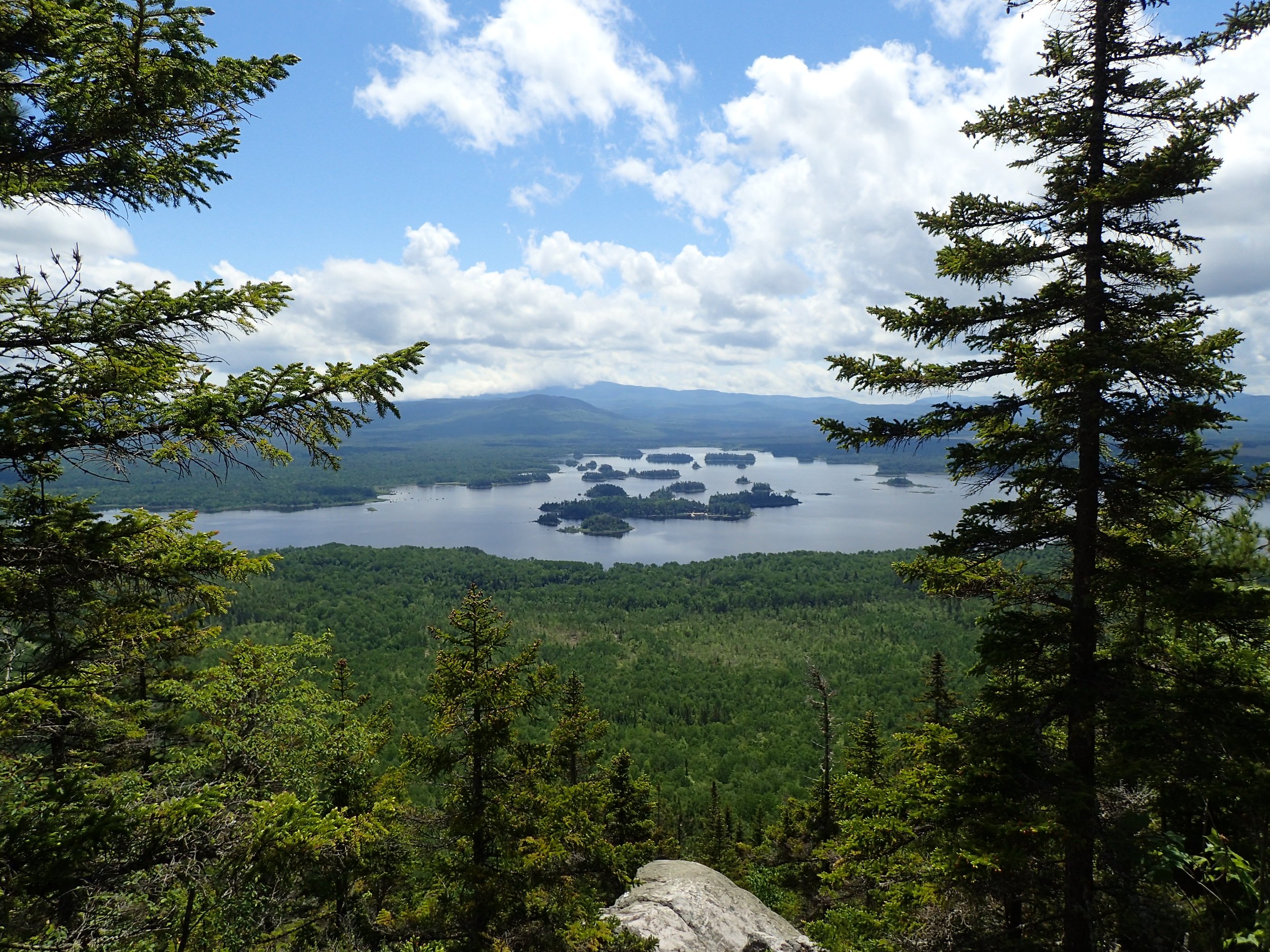The Benefits of Forest Conservation Easements
A recent study of Maine’s working forest conservation easements and a review of that research claim that these easements have not provided substantial ecological benefits, specifically that they had little effect on rates of forest loss or harvesting, compared to nearby forestlands.
As practitioners working actively to conserve Maine’s forests, we offer a broader perspective on the benefits of working forest conservation easements.
Maine’s forests are essential
First, it’s important to highlight that Maine’s forests are globally significant. They are the core of the Northern Appalachian/Acadian forest, one of the most intact temperate mixed forests in the world and an Important Bird Area.1
These forests are essential to maintaining large scale habitat connectivity and to carbon sequestration and storage.
The landscape around Attean Pond in western Maine is critical in providing landscape connectivity in the Northern Appalachians. Photo © Forest Society of Maine
Forest connectivity depends on easements
Great strides have been made in recent decades to connect conservation lands across Maine and into New Hampshire, Quebec, and New Brunswick. Nearly 22 percent of Maine’s land is now permanently conserved — mostly through conservation easements on private lands. Many landowners are not willing to sell their land but have been willing to negotiate easements. Ensuring connectivity of forest habitats between conservation lands owned by the state or by NGOs would be impossible without easements.
Easements eliminate development risks
Some people view the North Woods as being immune to development because it is remote, but there are growing development pressures, including for second homes, roads, and extraction of minerals, as well as poorly sited energy facilities and transmission corridors, that present significant impacts to resilient and connected forests. Easements have already stopped development proposals that would irrevocably fragment the uniquely undeveloped North Woods.
Easements contribute to protection of priority ecosystems and habitats
Working forest easements typically require that forest management plans address rare, threatened, or endangered plants and natural communities (which have no other legal protection in Maine). Many working forest easements are also crafted to ensure that habitat for rare, threatened, or endangered wildlife species or species of concern be managed appropriately.
A growing portfolio of easements has been crafted to address additional values such as providing stronger protection for riparian areas. Some easements require forest stocking be maintained above certain thresholds. Even within working forest easements, not all acreage is open to timber harvest. Many such easements designate ecological reserves (sometimes called Ecological Protection Zones or Special Treatment Areas) where nature is left to take its course and no forest harvesting or timber management is permitted.
Easements ensure the productive capacity of the forest
Forest conservation easements typically require that the forest be managed over time to ensure the productive capacity of the forestland is not impaired. This provides a level of protection above and beyond Maine regulations and laws, which don’t provide this type of assurance.
Easements maintain public access
Many working forest easements provide some form of permanent assurance for public access, allowing for traditional and low-impact activities. As we watch such traditions in other states vanish, and see more lands being posted here in Maine, having assured public access becomes ever more important.
Easements are a natural climate solution
The Maine Climate Council’s Maine Won’t Wait report, citing a recent UMaine study, couldn’t be more clear: Maine’s forests now sequester over 60 percent of the annual greenhouse gas emissions emitted in Maine annually. This percentage rises to about 75 percent when the capture of carbon in wood products is included.2 Conversion and loss of Maine forests is a threat to wildlife, to economic livelihoods, to recreationists in Maine, and to the worldwide effort to minimize climate change. The report specifically recommends employing working forest conservation easements to help keep Maine’s forests intact to ensure the opportunity for future carbon sequestration.
Easement terms evolve
It comes as no surprise that a survey of easements written two or three decades ago shows that they are not as sophisticated as they are now. Some early working forest easements were created to preclude very specific development opportunities and allow forest management to continue without much additional guidance. Over time, forest conservation easements have evolved by employing stronger standards for protection of forest ecosystems, and now are evolving to consider the important connections of Wabanaki people to Maine’s forests. Easements can also be amended to add new levels of protection, though this can be legally cumbersome. In addition, overlay easements by a third party can add strength to an original document.
Successful conservation requires multiple approaches
While working forest easements provide numerous benefits, they are not always the best tool in all situations. Restoration and maintenance of older forest habitat may be best accomplished through fee acquisitions by public agencies or land trusts to enable ecologically focused management or creation of ecological reserves, where no timber harvesting at all occurs. Easements are not only complementary to such acquisitions: they often help facilitate them as part of larger projects that serve multiple goals.
We have a chance to work together, using all available conservation tools to retain the 12 million acres in Maine’s North Woods as a natural, unfragmented, undeveloped landscape. Conservation easements have already served as and remain an essential strategy to achieve this goal for this globally significant forest.
1 Sources: McMahon, J. 2016. Diversity, Continuity and Resilience — The Ecological Values of the Western Maine Mountains. Maine Mountain Collaborative; The Nature Conservancy. 2024. Conserving the Appalachians: Hope in a Changing Climate. Priority Landscapes; National Audubon Society. 2024. Public Reports. Important Bird Areas.
2 These numbers come from USDA Forest Service Forest Inventory and Assessment data.
Mark Berry, Forest Program Director, The Nature Conservancy in Maine
Robert T. Perschel, Executive Director, New England Forestry Foundation
Steve Tatko, Vice President of Land, Research, and Trails, Appalachian Mountain Club
Karin Tilberg, President/CEO, Forest Society of Maine

